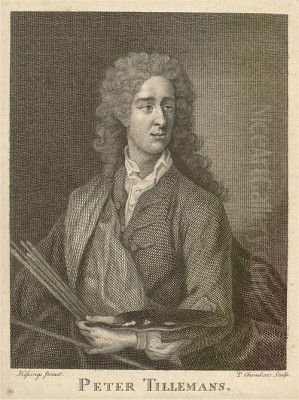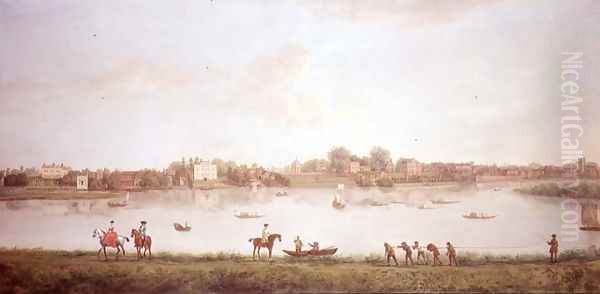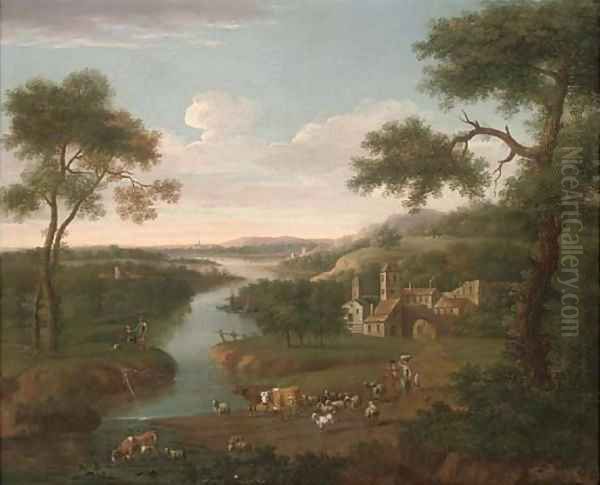Introduction to an Influential Artist

Peter Tillemans stands as a significant figure in the transition of art in early 18th-century England. Born in Antwerp in 1684, he brought his Flemish artistic sensibilities to Britain, where he became renowned primarily for his detailed landscapes and pioneering work in sporting art. His arrival marked a point of enrichment for the British art scene, blending continental traditions with the burgeoning tastes of the English aristocracy and gentry. Tillemans was not merely a painter of places and pastimes; he was instrumental, alongside contemporaries like John Wootton and James Seymour, in establishing the foundations of the English school of sporting and landscape painting, leaving a lasting legacy that influenced generations of artists. His meticulous technique and diverse subject matter secured him considerable patronage and a firm place in art history.
Early Life and Relocation to England
Peter Tillemans entered the world in Antwerp, a city then still resonating with the artistic triumphs of the Flemish Baroque. His birth year was 1684, into a family connected to the arts and crafts; his father was a diamond cutter, suggesting a background where precision and skilled handiwork were valued. Some accounts also mention his mother being a painter, potentially providing an early artistic influence. While details of his formal training in Antwerp remain somewhat scarce in the provided records, it is known that he initially focused on landscape painting. However, his talents were versatile, extending to the ability to skillfully replicate the works of established masters, including the genre scenes of David Teniers the Younger and the battle paintings of Jacques Courtois, known as Il Borgognone or Le Bourguignon.

The pivotal moment in Tillemans' career came in 1708. He travelled to England, not alone, but in the company of his brother-in-law, another artist named Pieter Casteels III. Their arrival was facilitated by a dealer, identified in sources sometimes as Edmund Treherne and other times as Henry Blom Turner. This move placed Tillemans directly into the developing London art market. Working initially for this dealer, Tillemans likely continued honing his craft, potentially copying works by Teniers and Borgognone as part of his duties, a common practice for artists seeking to establish themselves and demonstrate their technical prowess to potential clients and patrons in a new environment. This relocation proved immensely successful, launching a career that would see him become a sought-after artist in his adopted homeland.
Artistic Style, Techniques, and Subjects
Peter Tillemans developed a distinctive artistic style characterized by its precision, realism, and meticulous attention to detail. His Flemish roots are evident in the careful rendering of textures and surfaces, but his work evolved to suit the preferences of his English clientele. He became particularly adept at topographical views, country house portraits, and scenes depicting the sporting life cherished by the British aristocracy, such as horse racing and hunting. His ability to capture the likeness of specific locations, often panoramic country estates or famous sites like the Newmarket racecourse, made his work highly desirable for landowners wishing to document their holdings and lifestyle.
Technically, Tillemans was proficient in oil painting but also notably skilled in using a mixture of watercolour and gouache. This combination allowed for fine detail and delicate atmospheric effects, particularly suited to his landscape and topographical work. His paintings often feature expansive vistas populated with small figures, horses, and dogs, all rendered with remarkable accuracy. Whether depicting the rolling English countryside, the architectural specifics of a stately home, or the dynamic energy of a hunt or race, Tillemans maintained a high level of finish and observational clarity. This commitment to detailed realism became a hallmark of his contribution to English art.
His subject matter was diverse, reflecting the interests of his patrons. He painted numerous views of country seats, providing invaluable records of early 18th-century estates and gardens. His sporting scenes, especially those involving horses, were particularly celebrated. He captured the elegance and power of thoroughbreds, the excitement of the hunt, and the social gatherings associated with these aristocratic pursuits. Architectural elements were also rendered with care, whether as the main subject or as part of a larger landscape composition. This versatility ensured a steady stream of commissions throughout his career in England.
Notable Works and Prestigious Commissions

Throughout his career in England, Peter Tillemans produced a significant body of work, much of it commissioned by prominent figures. Among his most celebrated pieces is The Equestrian Portrait, noted for its elegant depiction of the rider, horse, and surrounding landscape, perfectly capturing the grace and status associated with the subject. Another well-known work is The Thames at Twickenham, dated around 1724 or 1725. This painting offers a serene view of riverside life near London, showcasing his skill in rendering tranquil English scenery and capturing the atmosphere of the period.
Tillemans received numerous commissions from the aristocracy and gentry. He painted several views of the famous Newmarket racecourse, often panoramic in scope, documenting the heartland of English horse racing. These works were highly sought after, with examples finding homes in collections such as Knowsley Hall. He was commissioned by the 4th Lord Byron to paint views of Newstead Abbey, the ancestral Byron home. Interestingly, some sources claim these Newstead views were later purchased by Joseph Goupy, who is confusingly described in one account as a student of William Blake (a chronological inconsistency, as Blake lived later, but reported as per the source material).
Further commissions included views of Chatsworth House in Derbyshire and Houghton Hall in Norfolk. He painted a shooting party featuring the 2nd Duke of Kingston, a work housed at Thoresby Hall. His reputation also led to illustration work; he contributed drawings for John Bridges' History and Antiquities of Northamptonshire and later provided illustrations for Horace Walpole’s seminal Anecdotes of Painting in England. Some sources also mention a commission to paint scenes for the Opera House in the Haymarket, London, which were reportedly purchased by Joseph Goupy for fifty guineas each. A particularly intriguing, though chronologically problematic, claim found in the source material mentions a portrait painted for King James I, which would place it well before Tillemans' active period; this may be a confusion with a later monarch or simply an error in the record. Regardless, his client list included figures like King George II, Frederick, Prince of Wales, and the Duke of Marlborough, confirming his high standing.
Interactions with Contemporary Artists and Influence
Peter Tillemans was an active participant in the London art world, interacting with numerous other artists, dealers, and patrons. His closest artistic connection upon arrival was his brother-in-law, Pieter Casteels III, with whom he travelled to England. Both initially worked for the dealer Turner (Treherne/Blom Turner). Tillemans' skill quickly brought him into contact with leading figures. He is considered a foundational figure of the English sporting art school, sharing this distinction with contemporaries John Wootton and James Seymour. Their collective work defined the genre in the early 18th century, focusing on horses, racing, and hunting scenes demanded by patrons.
Tillemans also played a role as an educator. The artist Arthur Devis is documented as having been his pupil in London. Devis studied landscape painting under Tillemans and initially worked in his style, also imitating Italian view painters like Giovanni Paolo Panini and Marco Ricci (likely the "Marco-Ponini" mentioned in one source). Devis's early work, such as views of Hoghton Towers, clearly shows his master's influence. This teaching role demonstrates Tillemans' established position and his contribution to nurturing the next generation of English painters.
His network extended further. He collaborated with the noted Flemish sculptor Michael Rysbrack, who was also active in England, on at least one occasion involving terracotta work. He associated with the celebrated painter and satirist William Hogarth; accounts exist of them travelling together on tours in England, sharing interests in antiquarian subjects. Tillemans' work inevitably drew comparisons with others, particularly in the popular field of animal painting. While highly skilled, especially with horses, his depictions were later considered less anatomically precise than those by George Stubbs, who emerged as a dominant force in animal painting later in the century. Nevertheless, Tillemans' influence, particularly through his association with Wootton and Seymour, and the impact of artists like Francis Barlow on his own horse portraiture, was crucial. Sources also mention interactions with lesser-known artists like Michael van Prinssen and Alexander Callot, suggesting a broad range of professional contacts.
Final Years and Lasting Legacy
Peter Tillemans remained active and respected throughout his career in England. His health, however, reportedly declined in his later years. He passed away on December 5, 1734, at Norton, Suffolk, while staying as a guest of Dr. Cox Macro, a notable patron and collector. He was buried shortly thereafter, according to the provided sources, at St Torles Church (likely St. Mary's Church) in Richmond, Surrey. His death marked the end of a productive career that significantly shaped the course of British art.
The legacy of Peter Tillemans is substantial. As a Flemish émigré, he successfully adapted his native tradition to the tastes and demands of the English market. His meticulous realism, particularly in topographical views and country house portraits, provided valuable historical records and set a standard for detailed landscape representation. More significantly, his role alongside John Wootton and James Seymour in establishing sporting art as a major genre in England cannot be overstated. They catered to the passions of the aristocracy, creating a visual language for depicting horses, racing, hunting, and the associated social milieu.
His influence extended through his pupils, like Arthur Devis, and through the general impact his popular style had on landscape and sporting painters who followed. He demonstrated how foreign-trained artists could thrive in England and contribute fundamentally to the development of distinctly British schools of painting. While later artists like George Stubbs might have surpassed him in specific areas like equine anatomy, Tillemans remains a crucial figure of the early Georgian period, admired for his technical skill, diverse output, and foundational role in key genres of English art. His works continue to be valued not only for their artistic merit but also for the window they provide into the world of 18th-century Britain.